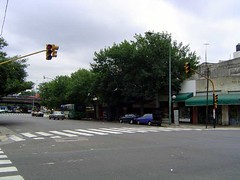Years ago when I first started reading Borges I remember being fascinated with all the streets of Buenos Aires that he mentions in his stories. At the time I never thought I would be living in Buenos Aires. And I never would have imagined that I would be living in a neighborhood that figures so prominently in so many of those stories.
When I’m out walking around I often think to myself that Borges himself wandered these very same streets. Before he lost his sight, he must have looked at many of these same buildings. Years from now, after I have long left Buenos Aires for some yet unknown part of the world, I will always remember my barrio through the story of Borges.
Yet, not all the streets have retained their character. One of the most important stories by Borges is El Aleph. It tells of a mystical encounter in the cellar of a house on avenida Garay. The location and the story El Aleph also play a prominet role in The Tango Singer by Tomás Eloy Martínez. In a recent New York Times travel article about Borges and Buenos Aires, Larry Rohter starts by telling us about his own experience on this anonymous street. Indeed, he describes Garay accurately as it is now a very bland street, one that would go unnoticed if not for this story by Borges.
I took a photo from the corner of avenida Garay and Tacuarí, which is just around the corner from the apartment. I cross this path several times every week. This particular block, where the mystical house was supposedly located, is one of the worse blocks in the entire neighborhood. Hate to ruin the illusion of the story but the narrator does tell us that the house was demolished, though the loss of the house saddened him: “After forty, every change becomes a hateful symbol of time’s passing.Ya cumplidos los cuarenta años, todo cambio es un símbolo detestable del pasaje del tiempo.”
El Aleph can be a complicated story but well worth exploring. Some familiarity with Dante would be useful but that shouldn’t scare anyone away. Not only is the woman of the story named Beatriz, there’s a character with a very Dantesque sounding last name: Daneri. Borges also brings the Kabbala into the story. While I’ve not mentioned it in this series, Borges had a strong interest in the Kabbala — long before it became fashionable.
El Aleph is an essential story for understanding the literature of Borges.
“I come now to the ineffable center of my tale; it is here that a writer’s hopelessness begins. Every language is an alphabet of symbols the employment of which assumes a past shared by its interlocutors….Does the Aleph exist, within the heart of a stone? Did I see it when I saw all things, and then forget it? Our minds are permeable to forgetfulness, I myself am distorting and losing, through the tragic erosion of the years, the features of Beatriz.
Arribo, ahora, al inefable centro de mi relato; empieza, aquí, mi desesperación de escritor. Todo lenguaje es un alfabeto de símbolos cuyo ejercicio presupone un pasado que los interlocutores comparten….¿Existe ese Aleph en lo íntimo de una piedra? ¿Lo he visto cuando vi todas las cosas y lo he olvidado? Nuestra mente es porosa para el olvido; yo mismo estoy falseando y perdiendo, bajo la trágica erosión de los años, los rasgos de Beatriz.”

June 18th, 2006 at 4:01 pm
Un dato familiar sobre Borges y la Cabalá. Se cono cieron cuando Borges estudiaba el secundario en Ginebra, en la biblioteca de su mejor amigo, nieto de rabinos cabalistas.
Un nieto de ese amigo es ahora el esposo de una prima mía. Viven en Washington DC.
June 18th, 2006 at 8:07 pm
Roberto – That is very interesting!
June 19th, 2006 at 2:12 pm
Great post, El Aleph has the ability of fascinating me every time I read it. I have even written one El Aleph story myself (which by no means can even be thought to resemble Borges’ one). Regards!
November 16th, 2008 at 11:29 pm
I read el Aleph many years ago and now, again. It denotes Borges knowledge
of universal literature. The most beautiful sensation is the rythm of his descriptions, how he keeps introducing you into the words, and at the same time remembering passages of other stories. Inmortality, an anguish, a desperation for finding the end of life, the last moment we know exists, but never when.
I write poetry and am preparing a website.
November 17th, 2008 at 12:10 pm
A part of me really wanted NOT to like Borges, to think that he was overrated. BUT, the more I read by Borges, the more wonderful is his writing. While Borges never fully transports me away from the awareness that I am reading Borges, I feel a enchanted with his words.
February 24th, 2010 at 12:39 am
I recently read El Aleph. The very first night I couldn’t put it down, when I finally did, I could not help creating my own story.
Borges vivira para siempre en sus obras!